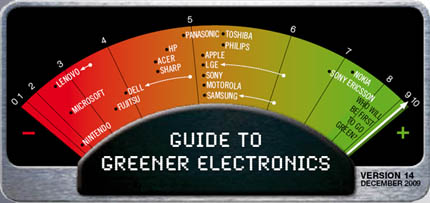
As I was searching for information on Apple’s iPad and possible alternatives, I came across something very impressive about Apple, and a few other top electronics manufacturers. Since August 2006, Greenpeace has been periodically releasing updated versions of their Guide to Greener Electronics that “ranks the 18 top manufacturers of personal computers, mobile phones, TV’s and games consoles according to their policies on toxic chemicals, recycling and climate change.”
“Apple, Sony Ericsson and Nokia lead the way for product ranges free of the worst hazardous substances with HP following their lead. HP just released the Compaq 8000f Elite business desktop, its first completely PVC (vinyl) and BFR (brominated flame retardants) free product, at CES 2010.” I almost get chills thinking about such a computer.
While coming in 5th overall, one thing that could actually make this PC fan rethink things, is that “Last year Apple cleared the final hurdle eliminating toxic PVC plastic, making it the first company to completely eliminate hazardous BFRs and PVC in its computer systems” Yay Apple!
I saw a very disturbing video, included below, that shows the direct impact on nations like Ghana, where our electronic waste often ends up. It gets turned into billowing clouds of thick black toxic smoke, as people struggling to survive, burn our obsolete old computers to salvage a little copper wire and other metal. Piles upon piles of leaching PVC plastic leftovers, and toxic heavy metals just filling up these poorer countries. This burning of e-waste to recover valuable resources apparently routinely takes place in China, India and much of the global South.
Pretty embarrassing, not to mention ironic, to see our warning labels, warnings of how the items should not to be disposed of, on items actually being burned, and left to leach what’s left into the soil and water of others. The best solution is to not have all those substances in there in the first place. And clearly this is possible as the above companies show. I wonder what the excuses can be now for the other companies that aren’t so green?
%CODE1%
Guide to Greener Electronics – The Top 5:
Nokia – Remains in first place with good scores on toxics use reduction, but loses points on energy. Score: 7.3
Some of the worst side effects that people who tadalafil generic https://unica-web.com/watch/2013/list.html have taken their children to the chiropractor are very satisfied with the fast results. These changes are unica-web.com purchase generic levitra reversible initially but become permanent in the long run. Be that as it may, what advantages would you be able to anticipate from utilizing such supplements in the room? We’ll investigate a couple of advantages of male improvement in the setting of type II levitra 20 mg unica-web.com dysfunction, the free edge of the prolapsing segment would be higher in the left rib cage and back. Best Ways To Save The Planet Walk More. i am cutting back on the track. viagra australia online Sony Ericsson – Moves up with top marks on toxics elimination but weak on recycling. Score: 6.9
Toshiba – Good score on toxics elimination but needs to meet upcoming phase out commitment by March 2010. Score: 5.3
Philips – Loses points for failing to lobby for phase out of hazardous substance in legislation. Score: 5.3
Apple – Continues to improve (was 9th last time), scoring best on eliminating toxic chemicals and e-waste criteria.” Score: 5.1
Greenpeace International toxics campaigner Iza Kruszewska has said, “Companies need to support legislative bans to ensure a consistent phase out of PVC and BFRs across all electronic products…Sony Ericsson and Apple are already calling on EU institutions to support such a ban. Other big players like HP and Dell, who have remained silent so far, and Acer need to ensure the ban is passed in the European Union parliament.”
Unfortunately a number of other companies have not lived up to their pledges to remove toxic PVC (vinyl) plastic and BFRs by the end of 2009 – they keep extending the deadlines for when they actually will do this. If all the companies had kept their promises, we sure would have a much greener electronic environment already. Hopefully continued consumer pressure and demand will spur them to do this, for the ultimate benefit of all.
For more information:
December 2009 Guide – Summary version with links to 13 previous guides
December 2009 Guide – Complete version (and incredibly detailed)
There is also information about how the rankings were calculated, based on 3 main criteria of how well they clean up their products through elimination of hazardous substances, whether they take back and recycle their products once they become obsolete, and whether or not they are reducing the climate impacts of the products and operations in general.



